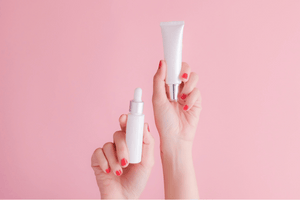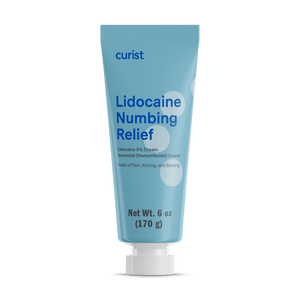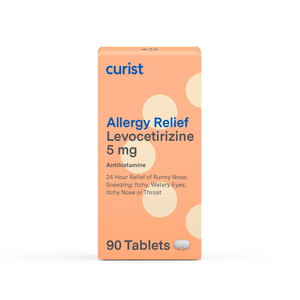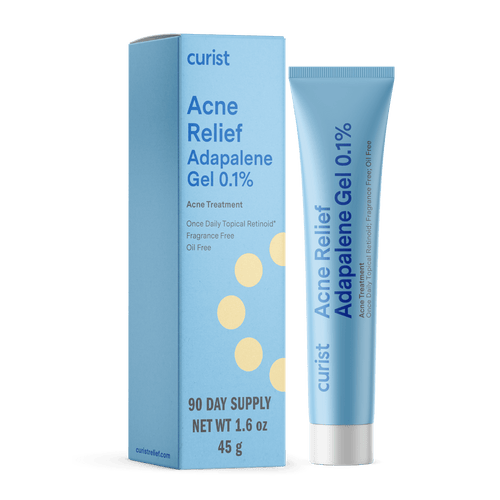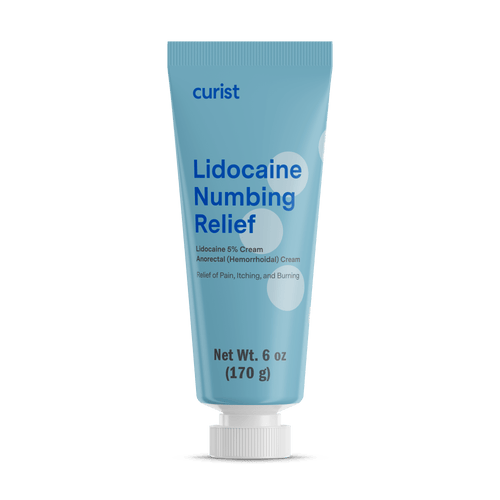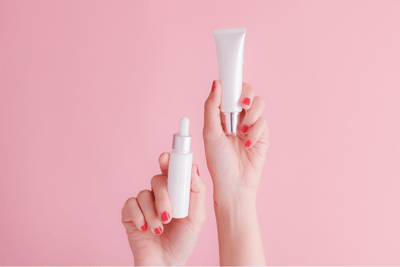By Ange Lu, The University of Texas at Austin College of Pharmacy
Curist delivers over-the-counter medicines to your door at a fraction of the price of traditional brands. We hope everyone stays safe and healthy during this time.
Are Adapalene and Benzoyl Peroxide the Same Thing?
Adapalene and benzoyl peroxide are not the same thing. Although both treat acne, they do so in very different ways.
Adapalene is a topical retinoid that increases cell turnover rates so that fresh, newer cells can move to the surface of your skin. Faster cell turnover helps clear clogged pores and prevent blackheads and whiteheads from forming in the first place. Additionally, adapalene is a key ingredient in reducing hyperpigmentation, aging, and inflammation in your skin.
Benzoyl peroxide is a topical bactericidal, meaning it kills bacteria under the skin, and is often used with other products, such as retinoids and azelaic acid. Benzoyl peroxide can be used for both non-inflammatory acne, such as blackheads and whiteheads, and for inflammatory acne (red bumps filled with pus) because of its bactericidal effect. Moreover, benzoyl peroxide reduces excess oil and unclogs pores through a mild peeling effect.
What are the Differences Between Benzoyl Peroxide and Adapalene?
Adapalene is a topical retinoid that is used to treat and prevent acne. Adapalene is a comedolytic, meaning it prevents clogged pores from forming and stops acne at the source. It has been touted by dermatologists as the holy grail of skincare ingredients for its anti-inflammatory properties and ability to promote cell turnover to reveal fresh, new skin. This process also gives adapalene anti-aging abilities that include improving hyperpigmentation, smoothing fine lines, and enhancing the texture of your skin. Adapalene 1% is also available over-the-counter as a gel and is the main ingredient of Curist Acne Relief!
Benzoyl peroxide is a topical bactericidal and is often used in combination with other products to treat acne. Benzoyl peroxide gets rid of bacteria and helps remove the oil and dead skin cells clogging your pores through a peeling effect. This can be used for inflammatory acne and non-inflammatory acne, like blackheads and whiteheads. It is important to note that benzoyl peroxide’s peeling effect can cause redness, irritation, and sun sensitivity to the skin, especially if used in high concentrations. Because it is a peroxide, benzoyl peroxide also has strong bleaching effects and can discolor your hair and clothes if not carefully applied.
Is Adapalene More Effective than Benzoyl Peroxide? Is Benzoyl Peroxide More Effective than Adapalene?
According to some clinical trials, adapalene is more effective than benzoyl peroxide for treating acne. In one study, benzoyl peroxide 2.5% was able to significantly decrease the number of inflammatory acne within the first month. However, adapalene 0.1% was able to dramatically decrease the number of non-inflammatory acne and overall acne after two to three months. That means that adapalene is more effective for mild to moderate acne!
Adapalene is often preferred if you have sensitive skin. Most people experience fewer side effects with adapalene compared to benzoyl peroxide, which can cause skin irritation because of its peeling effect.
You should always consult with your dermatologist and choose a product that works best for you and your skin. We recommend Curist Acne Relief, which uses adapalene as the main ingredient!
Is Adapalene Stronger than Benzoyl Peroxide? What is Stronger than Benzoyl Peroxide?
Adapalene and benzoyl peroxide can both be used to treat mild to moderate acne. They are often even used together! According to the American Academy of Family Physicians, adapalene and benzoyl peroxide can also be used in combination with topical antibiotics or azelaic acid in moderate cases of acne. However, salicylic acid should only be used for mild acne and should not be used with other acne products. For severe acne, additional oral antibiotics may be prescribed by your doctor.
What’s Best for Acne: Adapalene vs Benzoyl Peroxide?
Depending on the severity of your acne, you may decide to use adapalene, benzoyl peroxide, or both! Always consult with your doctor to help you pick the product that best suits your needs.
You may want to consider Curist Acne Relief, which contains adapalene 0.1%. Adapalene has been shown to have similar, if not better, efficacy in treating acne without as many side effects as benzoyl peroxide.
What’s Best for Wrinkles: Adapalene vs Benzoyl Peroxide?
Adapalene is a topical retinoid with anti-aging properties and can be used to help reduce fine lines and wrinkles. Adapalene increases skin cell turnover and helps exfoliate the skin to remove older skin cells and make room for new ones to appear. To learn more about the anti-aging benefits of adapalene, please read Is Adapalene Good for Anti-Aging?
Can I Use Adapalene and Benzoyl Peroxide Together? Can I Use Benzoyl Peroxide and Adapalene on the Same Day?
Adapalene and benzoyl peroxide are often used together to treat acne. They are sometimes even combined in the same bottle! If the products are separate, a mild benzoyl peroxide product used during the day and an adapalene gel used at night is highly effective for treating acne.
Can I Use Benzoyl Peroxide and Adapalene Alternatively?
For best results, you can alternate products so that you are using benzoyl peroxide in the morning and adapalene in the evening. After applying benzoyl peroxide in the morning, make sure to wear sunscreen to protect your skin from being irritated from the sun. Always follow the directions on the product label.


